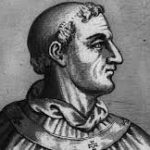
Pope Gregory VI was the sixth man to use the Gregory name and the 148th pope of the Church. He also shared his name with an antipope who served several months in 1012. Known as the “Pope Who Bought the Papacy”, he ruled for just over one year.
Early Life
Before becoming Pope Gregory VI, he was a man known as Giovanni Graziano, which translates to John Gratian. He was born circa 1000 in Rome, Italy and likely belonged to a wealthy family. His first role within the Catholic Church was as the Archpriest of St. John by the Lion Gate. John worked for the Church in this position for several years and saw the issues that arose during the papacy of Pope Benedict IX.
Pope Benedict IX
Pope Benedict IX was an unusual choice for the bishops to make as he was only in his early 20s when his family forced him into Church work. There are some reports that he was around this age when he took on the papacy.
John was the newest pope’s godfather and listened as he complained about the papacy and talked about how he wanted a different life. Benedict then told his godfather that he wanted to leave the Church and marry his lover.
The Pope Who Bought the Papacy
John and Benedict would reach an agreement wherein John would give his godson a financial sum each month that he called a pension. In exchange, Benedict would hand over the papal throne.
The bishops agreed to this change and allowed John to ascend the papacy and become Pope Gregory VI, which would earn him the nickname of the Pope Who Bought the Papacy.
Pope Sylvester III
Though most supported Pope Gregory VI, Pope Sylvester III did not. He believed that the Bishop of Sabina should be the next pope and installed him in the position. Benedict was forced to return to Rome and demand that the bishop retire and hand over the papacy to Gregory. Facing opposition from those who believed he was not a good ruler, Gregory would eventually abdicate the throne and allow Clement II to become pope.
Council of Sutri
King Henry III heard of the problems in Rome and arrived to settle the dispute. He held the Council of Sutri, which deposed both Gregory VI and Benedict IX and led to the election of Pope Clement III. Gregory agreed to step down to prevent others from accusing him of simony and left with the king.
They would travel back to Germany where the former pope would remain for the rest of his life. He died more than a year after leaving the papacy of natural causes. There are no records relating to his burial place, though he likely died and was buried in Cologne.
Quick Facts About Pope Gregory VI
- The future Pope Gregory VI was born in Rome, Italy and named Giovanni Graziano.
- He was born circa 1000 AD.
- Pope Gregory VI died in 1048 AD.
- The pope was traveling through Germany at the time and likely died in Cologne.
- His papacy began on May 1, 1045.
- The papacy of Pope Gregory VI ended on December 20, 1046.
- His successor was Pope Clement II.
Interesting Facts About Pope Gregory VI
- Both Benedict IX and Gregory VI are among the only popes in history to resign and willingly walk away from the papacy.
- Though Gregory admitted that he bought his way into the papacy, most believed that he had good intentions and was only looking out for the interests of the Church.
- According to Church records, the papacy of Pope Gregory VI lasted for one year and 229 days, which is more than double the length of the papacy of Benedict IX. Benedict held this position for only 52 days.
- Most regard Sylvester III as an antipope and believe that he had little power in Rome. Even if Benedict did not return to help his godfather, most think that Sylvester would do little to damage the papacy of Gregory VI.
- There is some evidence to indicate that Pope Gregory VI died up to one year after his official death date.